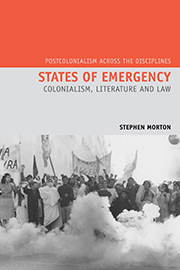Book contents
- Frontmatter
- Contents
- A Note on Translations
- Acknowledgements
- Introduction
- Part I
- Part II
- 3 States of Emergency, the Apartheid Legal Order and the Tradition of the Oppressed in South African Fiction
- 4 Torture, Indefinite Detention and the Colonial State of Emergency in Kenya
- 5 Narratives of Torture and Trauma in Algeria's Colonial State of Exception
- Part III
- Conclusion
- Bibliography
- Index
5 - Narratives of Torture and Trauma in Algeria's Colonial State of Exception
from Part II
- Frontmatter
- Contents
- A Note on Translations
- Acknowledgements
- Introduction
- Part I
- Part II
- 3 States of Emergency, the Apartheid Legal Order and the Tradition of the Oppressed in South African Fiction
- 4 Torture, Indefinite Detention and the Colonial State of Emergency in Kenya
- 5 Narratives of Torture and Trauma in Algeria's Colonial State of Exception
- Part III
- Conclusion
- Bibliography
- Index
Summary
In the opening sequence of Gillo Pontecorvo's 1965 film The Battle of Algiers, a group of French paratroopers feed a half-naked Algerian man a cup of coffee. Shivering and visibly terrified, this prisoner's nonverbal physical gestures clearly suggest that he has been tortured. These non-verbal signs of a body in pain are further confirmed by the appearance of the French military colonel in the cinematic frame, who inquires whether the man has talked, and by the threat that they will start all over again if the man refuses to comply with their demand that he help them locate one of the leading figures in the FLN, Ali la Point. In the subsequent scene, which follows the opening credits, the French paratroopers’ discovery of Ali la Point's hiding place at an apartment in the Casbah implies that the torture of the unnamed Algerian man in the previous scene has been successful.
This cinematic sequence is significant for a number of reasons. First, it suggests that the use of torture as a tactic of counter-insurgency is justified if it leads to the apprehension of ‘violent insurgents’, and to the prevention of a ‘terrorist attack’. Second, the sequence privileges the point of view of the French paratrooper in the counterinsurgency campaign against the FLN insurgents – a perspective that is prevalent in many literary and cultural representations of the Algerian war of independence, as we will see.
- Type
- Chapter
- Information
- States of EmergencyColonialism, Literature and Law, pp. 146 - 170Publisher: Liverpool University PressPrint publication year: 2013



